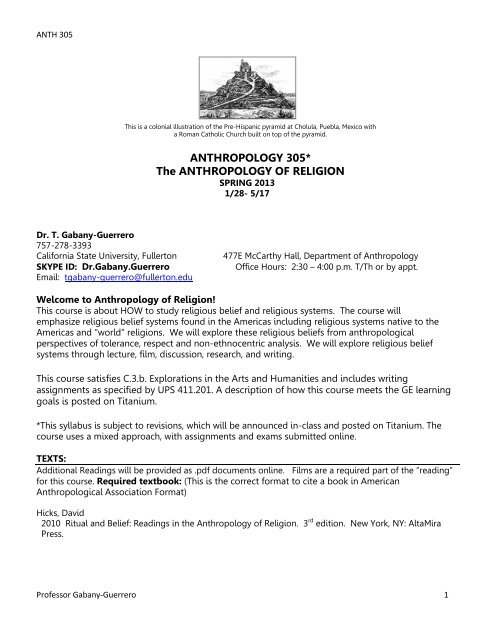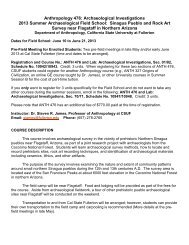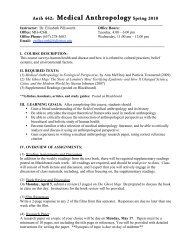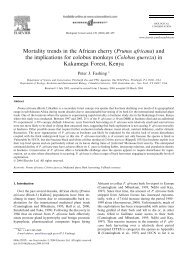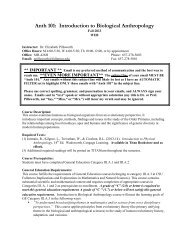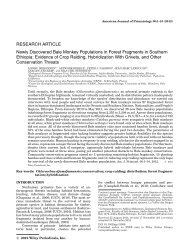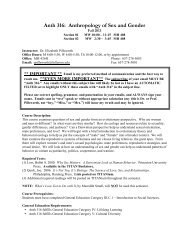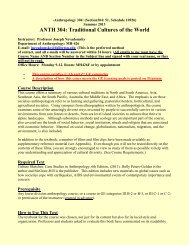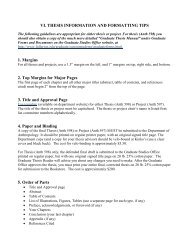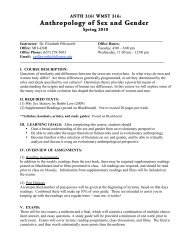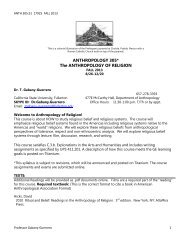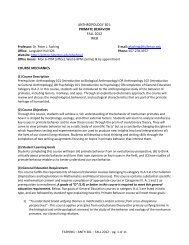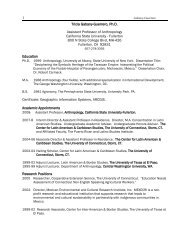anthropology 100 - CSUF Anthropology - California State University ...
anthropology 100 - CSUF Anthropology - California State University ...
anthropology 100 - CSUF Anthropology - California State University ...
You also want an ePaper? Increase the reach of your titles
YUMPU automatically turns print PDFs into web optimized ePapers that Google loves.
ANTH 305<br />
This is a colonial illustration of the Pre-Hispanic pyramid at Cholula, Puebla, Mexico with<br />
a Roman Catholic Church built on top of the pyramid.<br />
ANTHROPOLOGY 305*<br />
The ANTHROPOLOGY OF RELIGION<br />
SPRING 2013<br />
1/28- 5/17<br />
Dr. T. Gabany-Guerrero<br />
757-278-3393<br />
<strong>California</strong> <strong>State</strong> <strong>University</strong>, Fullerton<br />
SKYPE ID: Dr.Gabany.Guerrero<br />
Email: tgabany-guerrero@fullerton.edu<br />
477E McCarthy Hall, Department of <strong>Anthropology</strong><br />
Office Hours: 2:30 – 4:00 p.m. T/Th or by appt.<br />
Welcome to <strong>Anthropology</strong> of Religion!<br />
This course is about HOW to study religious belief and religious systems. The course will<br />
emphasize religious belief systems found in the Americas including religious systems native to the<br />
Americas and “world” religions. We will explore these religious beliefs from anthropological<br />
perspectives of tolerance, respect and non-ethnocentric analysis. We will explore religious belief<br />
systems through lecture, film, discussion, research, and writing.<br />
This course satisfies C.3.b. Explorations in the Arts and Humanities and includes writing<br />
assignments as specified by UPS 411.201. A description of how this course meets the GE learning<br />
goals is posted on Titanium.<br />
*This syllabus is subject to revisions, which will be announced in-class and posted on Titanium. The<br />
course uses a mixed approach, with assignments and exams submitted online.<br />
TEXTS:<br />
Additional Readings will be provided as .pdf documents online. Films are a required part of the “reading”<br />
for this course. Required textbook: (This is the correct format to cite a book in American<br />
Anthropological Association Format)<br />
Hicks, David<br />
2010 Ritual and Belief: Readings in the <strong>Anthropology</strong> of Religion. 3 rd edition. New York, NY: AltaMira<br />
Press.<br />
Professor Gabany-Guerrero 1
ANTH 305<br />
Syllabus Table of Contents<br />
1. Office Hours<br />
2. Titanium MOODLE<br />
3. Classroom Policies<br />
4. Emergency Procedures<br />
5. Texts<br />
6. Course Requirements and Grading<br />
7. Late Policies<br />
8. Quizzes and Exams<br />
9. Special Needs<br />
10. Citation Format<br />
11. Academic Integrity<br />
12. Class Schedule<br />
a. Orientation<br />
b. Module 1<br />
c. Module 2<br />
d. Module 3<br />
e. Module 4<br />
f. Module 5<br />
g. Module 6<br />
h. Module 7<br />
i. Module 8<br />
j. Module 9<br />
k. Module 10<br />
l. Module 11<br />
m. Module 12<br />
13. Assignment Details<br />
14. Background Course Information: G.E. Requirements.<br />
Office Hours and Communication<br />
The best way to reach me is through email.<br />
QUESTIONS ABOUT (Titanium) MOODLE:<br />
• In order to be successful in this course you MUST complete the student tutorials about<br />
how to use Titanium before beginning the course. See the ORIENTATION Module at the<br />
beginning of the course.<br />
• Titanium technical questions and problems should be directed to OASIS at 657-278-<br />
4866 M-F from 8 a.m. to 2 a.m. (yes, 2:00 a.m.!), or email oasis@fullerton.edu or call IT at<br />
(657) 278-7777 OR helpdesk@fullerton.edu. Technical questions are questions like: “I can’t<br />
view the videos, can someone help me with this?” or “I am not able to view or complete<br />
assignments or quizzes, how do I do that?” or “My computer won’t play the video, how can<br />
I fix that?”<br />
• In the event of technical problems that delay your submission of an assignment, report<br />
the technical problem to the HELP DESK AND send me an email. The HELP DESK will<br />
verify that TITANIUM was unavailable during the submission period.<br />
Professor Gabany-Guerrero 2
ANTH 305<br />
CLASSROOM POLICIES:<br />
Your respect and courtesy to your professor and colleagues are expected at all times.<br />
You will be asked to leave the class if any of the following occur:<br />
• Cell phone use<br />
• Surfing internet sites with a pc/mac. A pc/mac may be used in the classroom only to take<br />
class notes.<br />
• Reading other material, doing crosswords, IMing, texting, etc.<br />
• Conversations with your colleagues during lecture<br />
• Inappropriate language<br />
• Abusive behavior toward colleagues or professor<br />
Emergency Procedures Notice to Students<br />
The safety of all students attending <strong>California</strong> <strong>State</strong> <strong>University</strong> Fullerton is of paramount importance.<br />
During an emergency, it is necessary for students to have a basic understanding of their personal<br />
responsibilities and the <strong>University</strong>’s emergency response procedures. In the event of an emergency, please<br />
adhere to the following guidelines.<br />
Before an emergency occurs:<br />
• Know the safe evacuation routes for your specific building and floor.<br />
• Know the evacuation assembly areas for your building.<br />
When an emergency occurs:<br />
• Keep calm and do not run or panic. Your best chance of emerging from an emergency is with a clear<br />
head.<br />
• Evacuation is not always the safest course of action. If directed to evacuate, take all of your belongings<br />
and proceed safely to the nearest evacuation route.<br />
• Do not leave the area. Remember that faculty and other staff members need to be able to account for<br />
your whereabouts.<br />
• Do not re-enter building until informed it is safe by a building marshal or other campus authority.<br />
• If directed to evacuate the campus, please follow the evacuation routes established by either parking or<br />
police officers.<br />
After an emergency occurs:<br />
• If an emergency disrupts normal campus operations or causes the <strong>University</strong> to close for a prolonged<br />
period of time (more than three days), students are expected to complete the course assignments listed<br />
on the syllabus as soon as it is reasonably possible to do so.<br />
• Students can determine the <strong>University</strong>'s operational status by checking the <strong>University</strong>'s web site at<br />
http://www.fullerton.edu, calling the <strong>University</strong>'s hotline number at 657-278-4444, or tuning into area<br />
radio and television.<br />
Professor Gabany-Guerrero 3
ANTH 305<br />
COURSE REQUIREMENTS AND GRADING:<br />
8 QUIZZES (@ 50 points) 400<br />
Film Critique Research Bibliography 20<br />
Classroom Discussion (3 @10 points) 30<br />
Film Critique about Religion 50<br />
TOTAL 500<br />
*Proactive Participation means:<br />
• ABSOLUTELY NO texting or surfing or chatting during class<br />
• Coming to class prepared to discuss the assigned<br />
readings<br />
• Contributing constructively to the discussion of the<br />
assigned readings<br />
• Bring your course notebook with notes on readings, your<br />
assignments, etc. to class.<br />
Grading Scale:<br />
98-<strong>100</strong> % A+ 95-97 % A 90-94 % A-<br />
88-89 % B+ 84-87 % B 80-83 % B-<br />
78-79 % C+ 74-77 % C 70-73 % C-<br />
68-69 % D+ 56-67 % D 50-55 % D-<br />
0-49 % F<br />
LATE POLICIES:<br />
All Assignments will be posted on TITANIUM under the Week in which they are due as well as under<br />
the ASSIGNMENTS button. Work is considered late if emailed after midnight on the date due. I will<br />
deduct 5 points off per day or partial day late.<br />
QUIZZES or EXAMS:<br />
The quizzes will consist of objective questions (e.g. multiple-choice) which may cover films,<br />
readings and lectures.<br />
Make-up exams will be given only in emergency medical situations. A physician’s note must be<br />
provided to the professor, and you should contact the professor before the scheduled exam if<br />
possible. Make-up exams are NOT automatically allowed. Notify the professor in advance of the<br />
exam if you cannot take the exam at the scheduled time. Make-up exams will be allowed only<br />
for verifiable and unavoidable reasons like hospitalization of yourself or a family member<br />
or an accident. If allowed, a make-up exam must be taken within one week of the scheduled test<br />
date. Grading: See the chart above.<br />
SPECIAL NEEDS:<br />
• During the first week of classes, inform me of any disabilities or special needs that you have that<br />
may require special arrangements related to attending class sessions, carrying out writing assignments, or<br />
taking examinations.<br />
• Students with disabilities must document the disability at the Office of Disabled Student Services in<br />
UH 101, call (657) 278-3117 and communicate via the web http://www.fullerton.edu/disabledservices/<br />
Professor Gabany-Guerrero 4
ANTH 305<br />
CITATION FORMAT<br />
Please take note that all papers and assignments require that you use the Anthropological citation<br />
format from the American Anthropological Association (www.aaanet.org). The AAA guide is provided as a<br />
.pdf document for you. <strong>University</strong> students should be familiar with how to use ENDNOTE, a free<br />
bibliography software that is available to you through the Pollak Library portal. This online software<br />
program will assist you with collecting your bibliographic sources AND formatting them in AAA format.<br />
This is a requirement for your paper.<br />
• Click on the LIBRARY REFERENCE RESOURCES module in Titanium. A tutorial is provided<br />
for you about how to access the <strong>anthropology</strong> databases at Pollak Library and a second<br />
tutorial is available about how to use ENDNOTE.<br />
• Do not email the professor about how to use ENDNOTE – CONTACT THE LIBRARY – they<br />
have 24-7 chat access.<br />
You are responsible for reading the information and applying the guidelines to ALL written assignments for<br />
the class. Points will be deducted for incorrect citation format.<br />
Academic Integrity:<br />
Students who violate university standards of academic integrity are subject to disciplinary<br />
sanctions, including failure in the course and suspension from the university. Familiarize<br />
yourself with the academic dishonesty policy in the current student handbook or at<br />
http://fullerton.edu.senate/PDF/300/UPS300021.pdf<br />
Violations of the <strong>University</strong>’s Academic Misconduct policies will not be tolerated. Studying and<br />
working together is encouraged, but all written assignments MUST BE YOUR OWN WORK. Dishonesty<br />
includes, but is not limited to, cheating, plagiarizing, fabricating information or citations, facilitating<br />
acts of academic dishonesty by others, having unauthorized possession of examinations, submitting<br />
work of another person or work previously used without informing the instructor, or tampering with<br />
the academic work of other students. Fabrication of research data and/or plagiarism will result in a<br />
grade of “0” for the assignment and will be reported to Judicial Affairs. It is highly recommended<br />
that you consult the guide on how to avoid plagiarism, which can be accessed at<br />
http://www.fullerton.edu/deanofstudents/judicial/Plagiarism.htm.<br />
CLASS SCHEDULE<br />
• The course begins on Monday, 1/28 and ends on Friday, 5/17. The final exam will be held<br />
online during final exam week: 5/18-5/24.<br />
• Assigned reading should be done by early in the week, so that you are prepared to complete<br />
the assignments<br />
• Each week has several topics, readings and assignments. Films are interspersed throughout the<br />
semester and film questions will be completed as part of online submissions.<br />
• Make sure that you have read the entire syllabus and understand all of the requirements for the<br />
course. A syllabus is a guide for the semester. If any changes are necessary you will be notified<br />
that a change to the syllabus has been posted.<br />
• Titanium MOODLE is new for everyone. Modules will be posted one week in advance.<br />
• R&B refers to the Ritual and Belief textbook<br />
Professor Gabany-Guerrero 5
ANTH 305<br />
• Each week you are expected to view the online activities listed under Titanium for that week. There<br />
may be audio powerpoint lectures or specific learning activities for you to complete.<br />
Spring Semester Holidays:<br />
Monday, February 18 th , Presidents’ Day – CAMPUS Closed – no online classes<br />
Saturday, March 30 th – Sunday, April 7 th – SPRING Recess<br />
ORIENTATION<br />
Each module contains exercises.<br />
1/28 – 2/3<br />
By the end of the Orientation you will be able to:<br />
• Identify the key objectives of the course<br />
• Navigate and Complete assignments using Titanium<br />
• Create a Course Notebook<br />
View and discuss films:<br />
1. Ethnocentrism Video<br />
2. Race: Are We So Different?<br />
Read the Syllabus<br />
Make sure that you have read, in detail, the policy with respect to academic honesty,<br />
understand communication, submission and late policies, and the requirements for<br />
citations and bibliography.<br />
Complete Titanium Tutorials: Links are provided for you. Double-check that your computer settings<br />
are correct and you have all the required free programs downloaded and installed so that you can view and<br />
complete the assignments. Contact OASIS if you are having technical problems. (See note above on<br />
“Questions about Titanium.”)<br />
Create your Course Notebook. I highly recommend that you create a course notebook that follows the<br />
format provided for you in the Orientation (see online Course Notebook file). Online student learning<br />
benefits greatly from creating the notebook and using the “Cornell Method of Notetaking” (see online<br />
information provided for you.<br />
Take the online survey.<br />
All of the steps above must be completed by Monday, February 4th.<br />
Professor Gabany-Guerrero 6
ANTH 305<br />
MODULE 1<br />
By the end of Module 1 you will be able to:<br />
• Identify the key components of the discipline of <strong>anthropology</strong><br />
• Identify key terms in cultural <strong>anthropology</strong><br />
• Apply the anthropological definitions of race and ethnicity<br />
• Understand and apply the concepts of ethnocentrism, worldview and cultural relativism throughout this course<br />
• Identify and eliminate ethnocentric language in your own writing and communication<br />
2/4- 2/10: Introduction to Cultural <strong>Anthropology</strong><br />
Readings:<br />
Videos:<br />
1. Chapter 1 and Chapter 2: “Cultural <strong>Anthropology</strong>” by Kottak (on-line<br />
readings)<br />
2. “Race without Color” by Diamond (on-line reading)<br />
3. “Official <strong>State</strong>ment on Race” by The American Anthropological Association<br />
(on-line reading)<br />
1. Introduction to <strong>Anthropology</strong> - Faces of Culture<br />
Assignments:<br />
1. During each film you should be taking notes. To practice this<br />
process, answer the questions on the “Race: Are We So<br />
Different” Film Worksheet. You do not need to submit the<br />
answers, but answering the questions will prepare you for your first<br />
quiz.<br />
2. Discussion group assignments will be made during this week.<br />
3. Complete Multiple Choice Quiz #1 on readings and films. - due<br />
Monday,February 11th. Each Quiz is worth 50 points.<br />
Professor Gabany-Guerrero 7
ANTH 305<br />
MODULE 2<br />
By the end of Module 2 you will be able to:<br />
2/11- 2/17<br />
• Define key anthropological approaches to religion.<br />
• Apply terms from <strong>anthropology</strong> of religion<br />
• Identify specific historical perspectives in the analysis of religion (Tylor, Freud, Durkheim)<br />
• Conduct a library search for an <strong>anthropology</strong> article about an <strong>anthropology</strong> of religion topic using <strong>Anthropology</strong><br />
Plus database and save the search using ENDNOTE Web.<br />
• Understand and apply the <strong>anthropology</strong> (AAA) citation format to create a bibliography.<br />
Readings:<br />
Assignments:<br />
1. Chapter 3: “Religion” by Kottak (on-line reading)<br />
2. Perspectives: Readings Introduction, 1-1 and 1-3 in R&B (textbook)<br />
1. This quiz is heavily focused on mastery of the terminology in the<br />
<strong>anthropology</strong> of religion. Complete Multiple Choice Quiz #2 on<br />
readings. - due Monday, February 18th. Each Quiz is worth 50<br />
points.<br />
2. Research at the Library on Thursday, 2/16. We will meet in the<br />
LIBRARY with Dr. Tschabrun: PLS – TBA.<br />
3. Select a film from the film critique assignment of interest to you<br />
(Example: Buddhist rituals). The bibliographic research for this<br />
assignment can help you to build your research for the Film Critique.<br />
Follow the instructions to select two <strong>anthropology</strong> articles from the<br />
<strong>Anthropology</strong> Plus database searching under the keywords that you<br />
selected. Create two (2) bibliographic entries in AAA format. If you<br />
have created your notebook, then use the last section to begin this<br />
assignment. This assignment takes time and care. Follow the tutorials<br />
provided for you and contact the LIBRARIAN at least three days before<br />
the assignment is due (AKA Friday, not Tuesday) if you have questions.<br />
Submit via Titanium -- due Monday, March 25 th by 11:55 p.m.<br />
Professor Gabany-Guerrero 8
ANTH 305<br />
MODULE 3<br />
By the end of Module 3 you will be able to:<br />
• Recognize the key components of myths and monomyths across cultures.<br />
• Apply the concept of “worldview” to the study of myths<br />
• Understand different approaches to the study of myths<br />
• Analyze the features that myths share cross-culturally and the specific differences that may occur in several cultural<br />
examples<br />
• Understand and apply the <strong>anthropology</strong> (AAA) citation format for written assignments.<br />
2/18 – 2/24<br />
Readings:<br />
1. Myth, Cosmology and Symbolic Classification: Readings 2-1, 2-2, and 2-3 in<br />
R&B (textbook)<br />
2. “Gilgamesh” from Hero Myths<br />
Video:<br />
Assignments:<br />
The Power of Myth by Joseph Campbell<br />
1. Reading Discussion #1: Discuss how the reading “Gilgamesh”<br />
meets at least two of the requirements for a “hero.” In-class<br />
discussion.<br />
2. Complete Multiple Choice Quiz #3 - due Monday, 2/25. Each<br />
Quiz is worth 50 points.<br />
Professor Gabany-Guerrero 9
ANTH 305<br />
MODULE 4<br />
By the end of Module 4 you will be able to:<br />
• Recognize the importance of symbols in religious belief systems<br />
• Understand the ways that symbols can be interpreted across cultures<br />
• Recognize alternative ways of conceptualizing time and sacredness<br />
• Recognize the key components of ritual<br />
• Identify different types of rituals and rites of passage<br />
2/25 – 3/3<br />
Readings:<br />
1. Ritual: Readings 4-1, 4-2, and 4-3 in R&B (textbook)<br />
Video:<br />
Assignments:<br />
The Popol Vuh, by Patricia Amlin, 62 minutes.<br />
1. Film Critique Assignment: Select a film from the list to view. View<br />
the film and take detailed observation notes. Follow the review<br />
format for the assignment (exactly with the subheadings indicated).<br />
Include two academic <strong>anthropology</strong> references about the ritual in<br />
your review. Due Friday 4/28 before 11:55 p.m. 50 points.<br />
2. Complete Multiple Choice Quiz #4 – due Monday, March 4th.<br />
Each Quiz is worth 50 points.<br />
Professor Gabany-Guerrero 10
ANTH 305<br />
MODULE 5<br />
By the end of Module 5 you will be able to:<br />
3/4 – 3/10<br />
• Recognize the characteristics of altered states of consciousness<br />
• Recognize how altered states of consciousness relate to religious experience<br />
• Observe and interpret specific examples of altered states of consciousness such as The Holy Ghost People<br />
• Recognize the key components of magic<br />
• Identify different approaches to the study of magic<br />
• Recognize the ways that magic and divination can be studied<br />
Readings:<br />
Video:<br />
Assignments:<br />
Magic & Witchcraft: Readings 7-1, 7-2, and 7-3 in R&B (textbook)<br />
Daugherty, “Serpent-Handling as Sacrament” ADDITONAL ONLINE<br />
READING<br />
The Holy Ghost People by Peter Adair<br />
1. Reading Discussion#2: Discuss how the reading “Serpent-<br />
Handling as Sacrament” helps to explain phenomena associated<br />
with altered states of consciousness observed in the film The Holy<br />
Ghost People Due In-Class.<br />
Professor Gabany-Guerrero 11
ANTH 305<br />
MODULE 6<br />
By the end of Module 6 you will be able to:<br />
• Describe the structure of a rite of passage.<br />
• Explain the concept of liminality.<br />
• Explain why body modification is a common element of a rite of passage.<br />
• Explain the importance of rituals in the domain of religion, including how they relate to the previously<br />
discussed concepts of worldview, myth and symbol.<br />
3/11 – 3/17<br />
Readings:<br />
Video:<br />
Assignments:<br />
Practitioners of Ritual: Readings 5-1, 5-2, and 5-3 in R&B (textbook)<br />
Taki Kudo, Shamanic Medium of Tsugaru<br />
1. Complete Multiple Choice Quiz #5 - due Monday, March 17 th .<br />
Each Quiz is worth 50 points.<br />
MODULE 7<br />
By the end of Module 7 you will be able to:<br />
• Recognize the ways that death is conceptualized across cultures<br />
• Compare and contrast specific examples of practices and beliefs regarding death and afterlife.<br />
3/18 -3/24<br />
Readings:<br />
Videos:<br />
Death: Readings 8-1, 8-2, and 8-3 in R&B (textbook)<br />
AND Body and Mind: Reading 6-2 in R&B<br />
The Tibetan Book of the Dead<br />
Assignments<br />
1. Reading Discussion#3: Discuss how The Tibetan Book of the Dead<br />
explains the death experience. How does this belief system relate<br />
to the symbols discussed by Reading 8-2? Due in class.<br />
Professor Gabany-Guerrero 12
ANTH 305<br />
MODULE 8<br />
By the end of Module 8 you will be able to:<br />
• Define gods and spirits and describe the characteristics of each.<br />
• Describe the characteristics of ancestor worship<br />
• Explain the meaning of the anthropomorphism in belief systems<br />
• Explain the differences between ghosts, vampires, and zombies, etc.<br />
3/25 – 3/29<br />
Readings:<br />
Videos:<br />
Gods, Spirits and Souls: Readings 3-1, 3-2, and 3-3 in R&B (textbook)<br />
Teotihuacan: City of the Gods<br />
Assignments<br />
1. Complete Multiple Choice Quiz #6 - due Monday,4/8. Each Quiz is<br />
worth 50 points.<br />
SPRING BREAK!!<br />
MODULE 9<br />
By the end of Module 9 you will be able to:<br />
4/8- 4/14<br />
• Explain the roles of gender and sexuality in religious practices<br />
• Compare and Contrast gender roles<br />
• Recognize the specific history of European and New England witchcraft examples<br />
• Outline the origins and basic beliefs of the Wicca religion<br />
Readings:<br />
Videos:<br />
Assignments<br />
Gender and Sexuality: Readings 9-1, 9-2, and 9-3 in R&B (textbook)<br />
AND Body and Mind: Reading 6-3 in R& B<br />
The Burning Times<br />
1. Reading Discussion #4: Discuss the religious roles of women as<br />
presented in The Burning Times. How does this contrast with the<br />
reading 3-1? due in class.<br />
Professor Gabany-Guerrero 13
ANTH 305<br />
MODULE 10<br />
By the end of Module 10 you will be able to:<br />
4/15 – 4/21<br />
• Explain what a revitalization movement is and under what circumstances one is<br />
likely to occur.<br />
• Describe the stages of a revitalization movement.<br />
• Identify the types of revitalization movements and provide an example of each.<br />
Readings:<br />
Videos:<br />
Assignments<br />
Agents of Change: Readings 11-1, 11-2, and 11-3 in R&B (textbook)<br />
Ghost Dance Religion<br />
1. Complete Multiple Choice Quiz #7– due Tuesday, 11/13. Each Quiz is<br />
worth 50 points.<br />
MODULE 11<br />
By the end of Module 11 you will be able to:<br />
• Compare and contrast new religious movements<br />
• Discuss religious rights in the U.S.<br />
4/22 – 4/28<br />
Readings:<br />
Religious Movements: Readings 12-1, 12-2, and 12-3 in R&B (textbook)<br />
Videos:<br />
A Seat at the Table or Jonestown<br />
Assignments<br />
Reading Discussion #5: Discuss anthropological perspectives on how “freedom of<br />
religion” has been interpreted in the United <strong>State</strong>s. Give examples from the readings<br />
and film, A Seat at the Table. Due in class<br />
Professor Gabany-Guerrero 14
ANTH 305<br />
MODULE 12<br />
By the end of Module 12 you will be able to:<br />
4/29 – 5/5<br />
• Back to the Future: How can ethnohistorical research illuminate religious<br />
studies?<br />
• Case study comparisons between Christianity, Buddhism and Islam<br />
Readings:<br />
Selected pages from<br />
Johnson, Donald and Jean Elliot Johnson<br />
2007 Universal Religions in World History: The Spread of Buddhism,<br />
Christianity and Islam to 1500. New York, NY: McGraw-Hill.<br />
Videos: The Buddha:the story of Siddhartha (2010)<br />
Assignments<br />
5/6 – 5/12<br />
Complete Worksheet/Study Sheet in class.<br />
Readings:<br />
Selected pages from<br />
Johnson, Donald and Jean Elliot Johnson<br />
2007 Universal Religions in World History: The Spread of Buddhism,<br />
Christianity and Islam to 1500. New York, NY: McGraw-Hill.<br />
Videos:<br />
The Kingdom of Heaven<br />
Complete Worksheet/Study Sheet in class.<br />
5/13 – 5/17<br />
Videos:<br />
A History of Christianity<br />
Assignments Complete Worksheet/Study Sheet in class.<br />
Reading Discussion #6: Compare and contrast the three case studies (Christianity, Islam and<br />
Buddhism). Give examples of at least two similarities and two differences among the religions<br />
from the readings (All of Module 12 and films). due in class<br />
FINAL EXAM: Quiz #8 will cover Modules 11 &12<br />
Professor Gabany-Guerrero 15
ANTH 305<br />
Detailed Assignment Instructions<br />
Assignment #1<br />
Citation and Bibliography Assignment<br />
• View the online library tutorial posted under Module 1 for the course.<br />
• Go to the Pollak Library Website for the ANTH 305 course.<br />
• Following the instructions provided in the tutorial, register in ENDNOTE<br />
• Search the <strong>Anthropology</strong> Plus database to identify at least two academic <strong>anthropology</strong> articles<br />
using the keywords:<br />
“religio*” and “solstic*”<br />
Or “archae*” and “calendar*”<br />
Or “archeo* and “calendar*”<br />
NOTE: The * after the word is important in an online search. The * means that any suffix<br />
after the letter will be included in the search. This provides you with a wider range of<br />
possible search results. Do not type the quote marks (“”) in your search.<br />
• Choose two articles of interest to you that pertain to the film you have chosen for your film critique<br />
assignment.<br />
• Save the bibliographic records for your two citations in ENDNOTE.<br />
• Create the citation in American Anthropological Association format. Copy and save your work from<br />
ENDNOTE to WORD.<br />
• Proofread your work before submission. ENDNOTE does a great job entering the basic information,<br />
but computers are not yet human, so you are responsible for double-checking that the citation<br />
formatting and spelling are correct. Use the AAA Guide. Most citations will be for an article in a<br />
journal.<br />
• Submit two bibliography entries in a WORD or .PDF document on Titanium.<br />
Worth 20 points.<br />
Example for a Journal Article Bibliographic Entry<br />
Single-spaced. One line between each bibliographic entry. Listed in alphabetical order by author last<br />
name.<br />
FORMAT DETAILS<br />
Author Last Name, Author First Name<br />
Year Article Title. Journal Title Volume(Issue):page-to-page.<br />
Moll, Luis C.<br />
2000 Writing as Communication: Creating Strategic Learning Environments for Students. Theory into<br />
Practice 25(3):202-208.<br />
Professor Gabany-Guerrero 16
ANTH 305<br />
Writing & Critical Thinking Assignment #2<br />
FILM CRITIQUE FORMAT<br />
You may choose to critique any of the films on the list below for this assignment. Review the<br />
requirements of the assignment before viewing the film so that you can take notes to answer the<br />
questions required for the assignment. Refer to the anthropological concepts covered in your<br />
textbook and assigned readings (Hicks and Kottak at a minimum).<br />
Number your responses to answer the questions in the exact order listed below. Follow the format<br />
exactly. Answer in paragraph format (not bulleted points) within each question. Follow the guidelines<br />
below for written assignments. Avoid ethnocentric language and commentary.<br />
BEFORE SUBMISSION<br />
1. Spell-check, grammar-check and style-check BEFORE submission. (If you do not know how to use<br />
this feature in WORD, see http://office.microsoft.com/en-us/word-help/check-spelling-and-grammar-<br />
HP010117963.aspx#_Toc289065079) Penalties will be applied for spelling, grammar and style errors as<br />
this is a class that fulfills the writing requirement for completion of <strong>CSUF</strong> General Education.<br />
2. Citations and References<br />
Use at least two bibliographic citations (in addition to Hicks (2010)), for definitions of basic concepts. No<br />
encyclopedia or popular magazine or newspaper references will be accepted. All information that is not<br />
your idea should be cited. Read the citation format requirements. Acceptable styles include:<br />
• According to Hicks (2010:24)<br />
• Kottak (2008:24) defines culture as, “definition.”<br />
• “Quote from an author” (Kottak 2008:24).<br />
3. Guidelines for all Writing<br />
• Spell check<br />
• Avoid using clichés and colloquial expressions<br />
• Eliminate ethnocentric statements and rephrase<br />
o<br />
o<br />
For example, don't assume that the reader shares your viewpoint<br />
Using "our" or "we" indicates that an assumption is made by the writer about shared<br />
culture. As anthropologists in this class, you are being trained to be specific about<br />
cultural references and not presume shared values or culture with the reader.<br />
• Avoid passive voice verbs - use active voice verbs<br />
http://andromeda.rutgers.edu/~jlynch/Writing/p.html#passive<br />
• Avoid ending a sentence with a preposition<br />
• Avoid split infinitives<br />
• Check for subject/verb and subject/object agreement<br />
• Avoid using the word "it" and "thing" - substitute a specific word<br />
• Plagiarism will not be tolerated. Understand what plagiarism is before beginning your<br />
assignment. See <strong>CSUF</strong> guidelines provided in the Orientation materials for the course.<br />
If the above advice is not familiar to you, you may wish to consult the <strong>CSUF</strong> Writing Center or the information posted at<br />
http://www.world-english.org/grammar.htm<br />
Professor Gabany-Guerrero 17
ANTH 305<br />
Film Critique<br />
Your NAME:<br />
Your Course:Section<br />
Film Title:<br />
Film Date:<br />
1. What are the objectives of the film? (About <strong>100</strong> words)<br />
2. What religion did you focus on in the film. Remember that multiple religions may be present.<br />
Describe the belief system that you have chosen to focus on in the critique (use bibliographic sources<br />
to support your statements). (About 200 words)<br />
3. What historical period does the film cover? (One paragraph = minimum 3 sentences)<br />
4. What "big questions" does the film attempt to address? (About <strong>100</strong> words)<br />
5. What anthropological concepts are addressed in the film? (Refer to Kottak and Hicks readings)<br />
(About <strong>100</strong> words)<br />
6. What anthropological concepts do you believe should have been addressed in the film? (About<br />
<strong>100</strong> words)<br />
7. How does the film show religious ritual? Give at least 1 descriptive example using details from the<br />
film. (About 300 words) Answer each subquestion in order.<br />
a. type of ritual – describe (use information from Hicks (2010), other course readings and bibliographic<br />
sources to support your writing) b. ritual processes – describe in detail (describe exactly what you<br />
observe using non-ethnocentric language c. people involved in the ritual - describe in detail – how is<br />
gender depicted? Age – is this an intergenerational ritual? Ethnicity? (Remember that anthropologists<br />
use the category of ethnicity rather than race (race is culturally constructed.)<br />
8. Conclusions: Provide your assessment of the film’s depiction of the religious ritual. Was there a bias<br />
in the film’s description? Support your response. What do you think the filmmakers could have done to<br />
more accurately or ethnographically represent the ritual? What did you learn from observing this<br />
depiction and reading the bibliographic sources? How did this help you to better understand the<br />
diversity of religious rituals?<br />
(About 300-400 words)<br />
9. Bibliography – List your bibliographic sources in alphabetical order (Last name of author), singlespaced,<br />
using AAA format. Do not provide annotations. All sources should have been cited from your<br />
writing above.<br />
Professor Gabany-Guerrero 18
ANTH 305<br />
Film Critique Choices<br />
You may choose any of the following films (provided for you online - hyperlinked) to create your critical review<br />
(based on the criteria for the assignment).<br />
Start your search for bibliographic sources for the film related to two topics: 1) historical context of the film; 2) a<br />
ritual, ceremony or religious practice of one of the ethnic or religious groups displayed in the film. Select the two<br />
sources (must be anthropological sources) from the <strong>Anthropology</strong> Plus database. The films are in no special order.<br />
Popol Vuh<br />
The Mission<br />
Bury My Heart at Wounded Knee<br />
Smoke Signals<br />
The Burning Times<br />
Rastafari<br />
Haro Hara Pilgrimage<br />
A Seat at the Table<br />
Saints and Spirits<br />
Voodoo and the Church in Haiti<br />
Jainism<br />
Skakti<br />
Three Sovereigns for Sarah<br />
Tibetan Book of the Dead<br />
Eduardo the Healer<br />
Senhora Apreciada<br />
Professor Gabany-Guerrero 19
ANTH 305<br />
Background Course Information for <strong>Anthropology</strong> of Religion 305<br />
COURSE DESCRIPTION: “Prerequisite: completion of General Education Category III.B.2. Beliefs and<br />
practices in the full human variation of religious phenomena, with an emphasis on primitive religions.<br />
The forms, functions, structures, symbolism, and history and evolution of religious systems.”<br />
This class is about the varieties of religious practices, symbolism and beliefs studied through the lens<br />
of <strong>anthropology</strong>. Cross-cultural techniques in <strong>anthropology</strong> provide tools to study the religious<br />
practices and beliefs from a wide variety of human experience. The course includes theory, approaches<br />
to the study of religion, and examines the diversity of religious practice and experience throughout<br />
history. Readings and discussion will include myth, ritual, symbols, shamans, native revitalization and<br />
millennialism. The course will take a geographical approach using examples from many cultures and<br />
focus a bit more on examples from the Americas. The learning experience will incorporate lectures,<br />
film, personal or field experience, group presentation, the internet and library research. As this course<br />
works to develop skills in analysis of religious belief and practice, religious activities will be viewed as<br />
forms of social and cultural expression within the context of history and culture. Utilizing a nonethnocentric<br />
approach, the course will explore the varieties of religious belief and experience in the<br />
spirit of respect, free inquiry and critical thinking.<br />
General Education:<br />
This course has the objective of improving your reading, writing, listening and interaction skills in<br />
concert with the university’s General Education goals for “Implications, Explorations, and Participatory<br />
Experience in the Arts and Humanities.” It also fulfills the Cultural Diversity requirement. The<br />
following comes from the <strong>University</strong> Catalog:<br />
Courses in III. B. 3. Implications, Explorations, and Participatory Experience in the<br />
Arts and Humanities include the following goals for student learning:<br />
1. To understand broad, unifying themes in the arts and/or humanities from cross-disciplinary<br />
perspectives.<br />
2. To solve complex problems that require artistic or humanistic understanding.<br />
3. To relate the arts and/or humanities to significant social problems or to other related disciplines.<br />
4. When deemed appropriate, to apply disciplinary concepts<br />
from the arts and/or humanities in a variety of settings, such<br />
as community-based learning sites and activities. Cultural<br />
diversity goals are:<br />
1. To understand that culture is socially constructed and fundamental to social interaction.<br />
2. To appreciate the complex relationships that gender, ethnicity and class bring to a discussion of<br />
society and culture.<br />
3. To understand that because we live in an inter-connected world, we need to understand the<br />
diversity and relationships within and among cultures.<br />
4. To recognize and evaluate how one's cultural history affects one's sense of self and relationship to<br />
others.<br />
Students will ideally master the following specific course objectives in ANTH 305:<br />
1. Understand and appreciate the concept of culture, from the perspective of anthropologists,<br />
as anadaptive mechanism that provides for survival of the human species.<br />
2. Identify similarities that unite the human species and variations in human cultures.<br />
3. Recognize and appreciate that there are a wide variety of “cultural solutions” to living on<br />
Earth.<br />
4. Analyze the specific relationships between culture, the individual and history.<br />
Professor Gabany-Guerrero 20
ANTH 305<br />
5. Recognize theoretical approaches to studying religious experience.<br />
6. Learn and apply the meanings of the basic concepts and terms used by cultural<br />
anthropologists.<br />
7. Apply some of the procedures used by anthropologists in studying cultures and religion.<br />
(Adapted from Faces of Culture Study Guide, 1999)<br />
Professor Gabany-Guerrero 21


